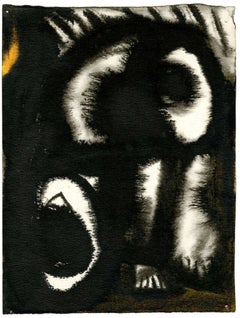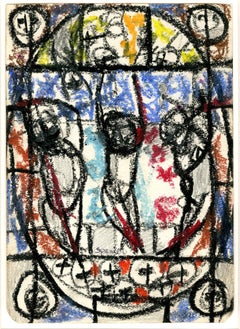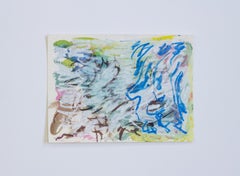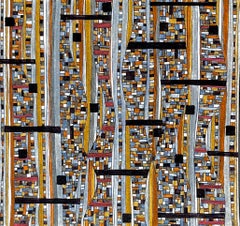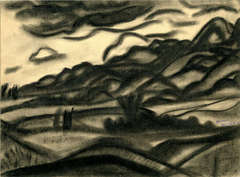Sam Spanier Art
to
2
2
2
Overall Height
to
Overall Width
to
2
2
1
1
2
6,938
3,292
2,514
1,213
1
1
1
1
1
Artist: Sam Spanier
Black and White Cat
By Sam Spanier
Located in Fairlawn, OH
Black and White Cat
Ink and watercolor on paper, c. 1970
Unsigned
Provenance:
Estate of the artist (Estate No. 737)
Condition: Excellent
Image/Sheet size: 4 3/4 x 6 1/4 inches
Sam Spanier (1925-2008)
Born in Brooklyn New York, Sam Spanier studied painting with Hans Hofmann (1949–50) and also at the Taos Valley Art School (1951). His formative years as a working artist were spent in Paris (1951–52), where he also became involved with the work of G. I. Gurdjieff, through his disciple, Mme. Jeanne de Salzmann.
By 1953, Spanier’s work had already begun to meet with critical acclaim. That year, he had his first solo gallery show, and was selected by Milton Avery and Hans Hofmann to receive the prestigious Lorian Fund Award. His second solo exhibition, in 1955, was curated by renowned museum director, Gordon Washburn. Spanier’s early work was reviewed by Dore Ashton, Donald Judd, Fairfield Porter, Stuart Preston, and Irving Sandler, among other significant critics of the period.
Spanier’s spiritual path increasingly became the central focus of both his life and his art. In 1960, he was introduced to the teachings of Sri Aurobindo, which led to visits to the Sri Aurobindo Ashram in Pondicherry, India, in 1962 and 1964, during which he was inspired to leave New York City and found Matagiri (in 1968)—a spiritual center in Woodstock, New York—with his lifelong partner, Eric Hughes. The work he embarked upon there bifurcates his life as an artist, separating him from New York’s art world, and radically altering the trajectory of his career. From that point forward, it would be difficult, perhaps impossible, to consider his artistic endeavor apart from the life of dedication he had undertaken, and to which he remained committed.
As early as 1954, Dore Ashton had recognized in Sam Spanier a “haptic visionary;” in 1960, Irving Sandler wrote that the people in Spanier’s paintings “seem to have witnessed some transfiguring event.” In his later paintings—usually worked in oil pastel on panel or paper—made during intermittent creative periods, from the mid-1970s to the final years of his life, the artist’s inner life remains always apparent in his subject matter; and from the portraits and abstract Buddha-like figures and heads, to the fantasy landscapes, the paintings are redolent with a rich intensity of color and light that can only be described as inspired.
Sam Spanier’s works are in the collections of the Historical Society of Woodstock Museum, and the Woodstock Artists Association & Museum. He received the Woodstock Artists Association Lifetime Achievement Award in 2007.
Selected Solo Exhibitions:
Urban Gallery, New York (1954, 1955, 1956); Wittenborn Gallery, New York (1958); Gallery Mayer, New York (1958, 1959, 1960); Unison Gallery, New Paltz (1986, 1995, 2009); Limner Gallery, New York (1988); Fletcher Gallery, Woodstock, New York (1999).
Selected Group Exhibitions:
Salon des Comparaisons, Musée d’Art Moderne, Paris, France (1952); October Exhibition of Oil Paintings, New York City Center Gallery, New York (1954); Salon de Mai, Musée d’Art moderne de la ville de Paris, Centre Culturel de Saint-Germain-en-Laye, Paris, France (1954); Carnegie International, Carnegie Institute, Pittsburgh, Pennsylvania (1955); Les Plus Mauvais Tableaux, Galerie Prismes, Paris (1955);
Première Exposition Internationale de l’Art Plastique Contemporain, Musée des Beaux-Arts de la Ville de Paris (1956); Recent Paintings USA: The Figure, The Museum of Modern Art (1960); Winter’s Work, Woodstock Artists Association, Woodstock, New York (1985); Juried Group Show, Woodstock Artists Association, Woodstock, New York (1986); Woodstock Artists, Self-Portraits, Historical Society of Woodstock Museum, Woodstock, New York (1988); Portraits, Albert Shahinian Fine Art, Poughkeepsie, New York (2003); The World We Live In, Upstate Art, Phoenicia, New York (2003); Show of Heads, Limner Gallery, Phoenicia, New York (2004).
Selected Writings on the Artist:
Dore Ashton, “Sam Spanier,” Art Digest (May 1, 1954) and “Sam Spanier,” The New York Times (March 16, 1960); Cassia Berman, “Sam Spanier: A Divine Calling,” Woodstock Times (February 7, 2008); Lawrence Campbell, “Sam Spanier: Exhibition of Paintings at Urban Gallery,” Art News...
Category
1970s Abstract Sam Spanier Art
Materials
Ink, Watercolor
Chorus Line
By Sam Spanier
Located in Fairlawn, OH
Chorus Line
Oil pastel on paper, c. 1960's
Signed (see photo)
Provenance: Estate of the Artist
Estate of the artist (Estate No. 745)
Condition: Excellent
Image/Sheet size: 5 3/4 x 4 inches
Sam Spanier (1925-2008)
Born in Brooklyn New York, Sam Spanier studied painting with Hans Hofmann (1949–50) and also at the Taos Valley Art School (1951). His formative years as a working artist were spent in Paris (1951–52), where he also became involved with the work of G. I. Gurdjieff, through his disciple, Mme. Jeanne de Salzmann.
By 1953, Spanier’s work had already begun to meet with critical acclaim. That year, he had his first solo gallery show, and was selected by Milton Avery and Hans Hofmann to receive the prestigious Lorian Fund Award. His second solo exhibition, in 1955, was curated by renowned museum director, Gordon Washburn. Spanier’s early work was reviewed by Dore Ashton, Donald Judd, Fairfield Porter, Stuart Preston, and Irving Sandler, among other significant critics of the period.
Spanier’s spiritual path increasingly became the central focus of both his life and his art. In 1960, he was introduced to the teachings of Sri Aurobindo, which led to visits to the Sri Aurobindo Ashram in Pondicherry, India, in 1962 and 1964, during which he was inspired to leave New York City and found Matagiri (in 1968)—a spiritual center in Woodstock, New York—with his lifelong partner, Eric Hughes. The work he embarked upon there bifurcates his life as an artist, separating him from New York’s art world, and radically altering the trajectory of his career. From that point forward, it would be difficult, perhaps impossible, to consider his artistic endeavor apart from the life of dedication he had undertaken, and to which he remained committed.
As early as 1954, Dore Ashton had recognized in Sam Spanier a “haptic visionary;” in 1960, Irving Sandler wrote that the people in Spanier’s paintings “seem to have witnessed some transfiguring event.” In his later paintings—usually worked in oil pastel on panel or paper—made during intermittent creative periods, from the mid-1970s to the final years of his life, the artist’s inner life remains always apparent in his subject matter; and from the portraits and abstract Buddha-like figures and heads, to the fantasy landscapes, the paintings are redolent with a rich intensity of color and light that can only be described as inspired.
Sam Spanier’s works are in the collections of the Historical Society of Woodstock Museum, and the Woodstock Artists Association & Museum. He received the Woodstock Artists Association Lifetime Achievement Award in 2007.
Selected Solo Exhibitions:
Urban Gallery, New York (1954, 1955, 1956); Wittenborn Gallery, New York (1958); Gallery Mayer, New York (1958, 1959, 1960); Unison Gallery, New Paltz (1986, 1995, 2009); Limner Gallery, New York (1988); Fletcher Gallery, Woodstock, New York (1999).
Selected Group Exhibitions:
Salon des Comparaisons, Musée d’Art Moderne, Paris, France (1952); October Exhibition of Oil Paintings, New York City Center Gallery, New York (1954); Salon de Mai, Musée d’Art moderne de la ville de Paris, Centre Culturel de Saint-Germain-en-Laye, Paris, France (1954); Carnegie International, Carnegie Institute, Pittsburgh, Pennsylvania (1955); Les Plus Mauvais Tableaux, Galerie Prismes, Paris (1955);
Première Exposition Internationale de l’Art Plastique Contemporain, Musée des Beaux-Arts de la Ville de Paris (1956); Recent Paintings USA: The Figure, The Museum of Modern Art (1960); Winter’s Work, Woodstock Artists Association, Woodstock, New York (1985); Juried Group Show, Woodstock Artists Association, Woodstock, New York (1986); Woodstock Artists, Self-Portraits, Historical Society of Woodstock Museum, Woodstock, New York (1988); Portraits, Albert Shahinian Fine Art, Poughkeepsie, New York (2003); The World We Live In, Upstate Art, Phoenicia, New York (2003); Show of Heads, Limner Gallery, Phoenicia, New York (2004).
Selected Writings on the Artist:
Dore Ashton, “Sam Spanier,” Art Digest (May 1, 1954) and “Sam Spanier,” The New York Times (March 16, 1960); Cassia Berman, “Sam Spanier: A Divine Calling,” Woodstock Times (February 7, 2008); Lawrence Campbell, “Sam Spanier: Exhibition of Paintings at Urban Gallery,” Art News (April 1, 1954); Sam Feinstein, “Sam Spanier: Exhibition of Paintings at Urban Gallery,” Art Digest (March 1, 1955); Pat Horner, “Big Heart, Timeless Art —Sam Spanier Retrospective at Fletcher Gallery, Woodstock Times (July 1, 1999); Donald Judd, “In the Galleries: Sam Spanier,” Arts Magazine (April 1960); Liam Nelson, “Human Force...
Category
1960s Abstract Sam Spanier Art
Materials
Oil Crayon
Related Items
Untitled
Located in København S, DK
Explore Mila Francesca Cali's abstract watercolors, inspired by her plein-air studies of space and nature. With echoes of modernist painting in a contemporary context, each piece res...
Category
2010s Abstract Impressionist Sam Spanier Art
Materials
Oil Crayon, Watercolor
Linda Turner, Art Meditation 18, Collage, Pattern and Decoration, Automatism
Located in Darien, CT
Linda Turner, raised both in NYC and Northern Virginia, resides in Brooklyn, NY. She achieved a BFA in Surface Design/Textile Design from the Fashion Inst...
Category
2010s Abstract Geometric Sam Spanier Art
Materials
Archival Ink, Watercolor, Gouache, Archival Paper, Pencil, Color Pencil
Linda Turner, Meditation Is Play, Collage, Pattern and Decoration, Automatism
Located in Darien, CT
Linda Turner, raised both in NYC and Northern Virginia, resides in Brooklyn, NY. She achieved a BFA in Surface Design/Textile Design from the Fashion Inst...
Category
2010s Abstract Geometric Sam Spanier Art
Materials
Watercolor, Pencil, Archival Ink, Gouache, Archival Paper, Color Pencil
Linda Turner, Art Meditation 12, Collage, Pattern and Decoration, Automatism
Located in Darien, CT
Linda Turner, raised both in NYC and Northern Virginia, resides in Brooklyn, NY. She achieved a BFA in Surface Design/Textile Design from the Fashion Inst...
Category
2010s Abstract Geometric Sam Spanier Art
Materials
Archival Ink, Watercolor, Gouache, Archival Paper, Pencil, Color Pencil
Linda Turner, Art Meditation 7, Collage, Pattern and Decoration, Automatism
Located in Darien, CT
Linda Turner, raised both in NYC and Northern Virginia, resides in Brooklyn, NY. She achieved a BFA in Surface Design/Textile Design from the Fashion Inst...
Category
2010s Abstract Geometric Sam Spanier Art
Materials
Archival Ink, Watercolor, Gouache, Archival Paper, Pencil, Color Pencil
Spirit (mid century modern abstract painting by artist daughter of MOMA founder)
Located in New York, NY
Victoria Barr
Spirit, 1974
Crayon on Paper
Signed and dated lower right front
Frame included
Provenance: Fischbach Gallery, New York, NY
This bright, abstract 1970s artwork was created by Victoria Barr, daughter of the legendary developer of the Museum of Modern Art, Alfred H. Barr. There is a Fischbach Gallery label on the back of the frame. The Fischbach Gallery was, for many years, the gallery of record for the American artist Alex Katz. It is not easy finding Barr's work on the market at this time.
Measurements:
Framed:
23 inches x 29.5 inches x .5 inches
Artwork:
23 inches x 29 inches
Victoria Barr was born in New York, NY, in 1937 to the legendary MOMA curator and art historian Alfred H. Barr, Jr. and art historian Margaret Scolari Barr. Barr often traveled to Europe with her parents from the age of 14 onwards, meeting influential artists like Pablo Picasso, Henri Matisse, and Marc Chagall and collectors like Peggy Guggenheim. For high school, she went to Milton Academy...
Category
1970s Abstract Sam Spanier Art
Materials
Oil Crayon, Graphite
H 23 in W 29.5 in D 0.5 in
Linda Turner, Art Meditation 5, Collage, Pattern and Decoration, Automatism
Located in Darien, CT
Linda Turner, raised both in NYC and Northern Virginia, resides in Brooklyn, NY. She achieved a BFA in Surface Design/Textile Design from the Fashion Inst...
Category
2010s Abstract Geometric Sam Spanier Art
Materials
Archival Ink, Watercolor, Gouache, Archival Paper, Pencil, Color Pencil
"Frozen Tracks in Snow", contemporary abstract landscape acrylic & crayon, paper
By Mel Reese
Located in Brooklyn, NY
An acrylic and caran d'ache abstract drawing of the moment in the season when it is so crips and quiet that your shoes make clear tracks frozen in the snow.
This drawing was produce...
Category
2010s Abstract Sam Spanier Art
Materials
Oil Crayon, Acrylic, Archival Paper
Black & Gold Glyphs III by Cheryl R. Riley, metallic abstract geometric symbols
By Cheryl R. Riley
Located in Jersey City, NJ
Black & Gold Glyphs III by Cheryl R. Riley
Metallic abstract geometric symbols
Gouache and metallic ink on 140# cold press watercolor paper
Feminist Art and Contemporary Feminist / ...
Category
2010s Abstract Geometric Sam Spanier Art
Materials
Gold Leaf
Abstraction (maroon)
Located in Provincetown, MA
Agnes Weinrich was born in Burlington, Iowa in 1873. She studied with French Cubist Albert Gleizes in Berlin, Paris, and Rome, and with Charles Webster Hawthorne and Blanche Lazzell ...
Category
Early 20th Century Abstract Geometric Sam Spanier Art
Materials
Oil Crayon
New York School Abstract Expressionist Drawing Watercolor Painting Carmen Cicero
By Carmen Cicero
Located in Surfside, FL
This is a stylized figurative abstract expressionist nude. This one appears to be possibly signed in the drawing itself. From the style we are estimating it to the 1970's
They have abstract stylized erotic male and female nude elements to them some have a stylized American flag.
Carmen Louis Cicero (born 1926) is an American figurative abstract painter from Newark, New Jersey. Cicero attended the New Jersey State Teachers College (now Kean University) from 1947 to 1951. Cicero studied painting under Hans Hofmann and Robert Motherwell at Hunter College in 1953. He received an MFA from Montclair State University in 1991.Cicero started as an abstract painter and use automatism in his drawings of memories of places. In 1957, Cicero had his first solo show at the Peridot Gallery, New York, showing with fellow artists Louise Bourgeois and Philip Guston. In the early 1960s, Cicero’s canvases began to be populated with intense, expressionist figures. These works positioned him as one of the earliest figurative expressionist painters of his generation. In 1971 a studio fire destroyed the work still in his possession. He moved to New York to a studio loft on the Bowery and started over in a dramatically different figurative style. In the 1990s, Cicero's style changed again, from figurative expressionism to visionary realism/surrealism reminiscent of magic realism. His work spans three periods and styles Abstract Expressionism, Figurative Expressionism, and surrealist “visionary.” In the late 1970s and 1980s and produced a body of work that was well received both uptown on Madison Avenue and downtown during the heyday of the East Village art scene. He was represented by the Berta Walker Gallery. He lives in New York City and Truro on Cape Cod. He is also an accomplished jazz musician.
Cicero taught painting at Sarah Lawrence College 1959 to 1968. Cicero was a professor of painting at Montclair State University from 1970 through 2001. A monograph, The Art of Carmen Cicero was published in 2013 by Schiffer Publishing in Atglen, PA.
Awards
Guggenheim Fellowship 1957-58 and 63-64
Ford Foundation, Purchase Prizes 1961 and 65
Jackson Pollock- Lee Krasner Foundation Grant, 2008
Jacob Lawrence and Gwendolyn Knight Lawrence...
Category
1970s Abstract Expressionist Sam Spanier Art
Materials
Watercolor, Ink
LA landscape from Jason's kitchen
Located in København S, DK
Explore Mila Francesca Cali's abstract watercolors, inspired by her plein-air studies of space and nature. With echoes of modernist painting in a contemporary context, each piece res...
Category
2010s Abstract Impressionist Sam Spanier Art
Materials
Oil Crayon, Watercolor
Previously Available Items
Burning Ember
By Sam Spanier
Located in Fairlawn, OH
Estate of the artist (Estate No. 736)
Category
20th Century Sam Spanier Art
Materials
Ink, Watercolor
New Mexico Desert
By Sam Spanier
Located in Fairlawn, OH
Signed, titled, and dated Taos, NM, 1950 center right
Provenance:
Estate of the artist (Estate No. 758)
Done while the artist was visiting Mabel Dodge Luhan...
Category
1950s Sam Spanier Art
Materials
Charcoal
Whoosh!
By Sam Spanier
Located in Fairlawn, OH
Signed and dated in ink upper center
Provenance:
Estate of the artist (Estate No. 744)
Category
1950s Sam Spanier Art
Materials
Ink, Paper
Cosmic Waves
By Sam Spanier
Located in Fairlawn, OH
Comes from the estate of the artist.
Representative of a meditational mandala.
Founder of Matagiri Sri Aurobindo Center in Woodstock, NY (a spiritual center focused on Multi-India...
Category
1960s Sam Spanier Art
Materials
Oil Pastel
Sam Spanier art for sale on 1stDibs.
Find a wide variety of authentic Sam Spanier art available for sale on 1stDibs. You can also browse by medium to find art by Sam Spanier in crayon, ink, oil crayon and more. Much of the original work by this artist or collective was created during the 20th century and is mostly associated with the abstract style. Not every interior allows for large Sam Spanier art, so small editions measuring 4 inches across are available. Customers who are interested in this artist might also find the work of Charles Clary, Toni Simon, and Vincent Vella. Sam Spanier art prices can differ depending upon medium, time period and other attributes. On 1stDibs, the price for these items starts at $700 and tops out at $750, while the average work can sell for $725.
